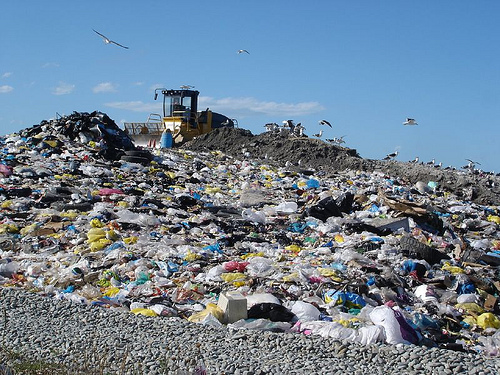 The renewable energy startup Ze-gen, Inc., has put a new spin on an old technology. Before the advent of the electric light bulb, many cities used coal gasification to provide fuel for their street lamps, and as the costs of oil and natural gas soar, many are reconsidering this old method in the hopes of providing cheaper sources of fuel. But there is a downside. Gasification works by using heat to convert solids into gas, and as we all know, burning coal tends to release large quantities of carbon dioxide, a major cause of global warming.
The renewable energy startup Ze-gen, Inc., has put a new spin on an old technology. Before the advent of the electric light bulb, many cities used coal gasification to provide fuel for their street lamps, and as the costs of oil and natural gas soar, many are reconsidering this old method in the hopes of providing cheaper sources of fuel. But there is a downside. Gasification works by using heat to convert solids into gas, and as we all know, burning coal tends to release large quantities of carbon dioxide, a major cause of global warming.
However, Ze-gen has come up with an alternative solution. Instead of using coal, which has numerous detrimental environmental effects, they are using garbage — waste that would otherwise be destined for landfills. For about two years now at a demonstration facility in New Bedford, Massachusetts, the company has been injecting what it terms biomass, organic waste from construction sites as well as municipal sources, into a vat of molten scrap metal.
Gasification using biomass produces a synthesis gas, or syngas in renewable energy parlance, composed mostly of carbon monoxide and hydrogen — which burn cleaner than the carbon dioxide produced from coal gasification. Heavy metals from the waste sink to the bottom of the vat, and lighter contaminants rise to the top where they are trapped in a crust of silica. These toxins and impurities can then be removed safely at a later time.
Ze-gen hopes to solve two problems at once: they will provide a cheaper, cleaner source of fuel while keeping tons of waste out of landfills — incidentally, also decreasing the amount of methane, a greenhouse gas just as bad as CO2, released by decomposing rubbish. The test facility has been going through 1 ton of waste every hour for 5 hours a day. Given that 300 million tons travel to landfills in the U.S. alone, the potential market is wide, and the positive impact on the environment staggering.
Now that Ze-gen’s test facility has proven the technology commercially viable, the company is ready to begin commercial implementation. On January 13, 2009, they announced that they have raised 20 million dollars to finance implementation. Waroz Holding Company, a subsidiary of the Omzest Group of Oman, led the investors, which also include FlagshipVentures and Massachusetts Technology Development Corporation. They plan to open full-scale commercial and industrial facilities by 2012.
Photo Credit: Samuel Mann at flickr




Why don’t we have numbers on this?
How much energy is created per ton? How costly is this versus landfills.
How large can they make it or better yet, can it be made portable on an 18 wheeler and it can “Harvest” land fills all over the country?
Why don’t we have numbers on this?
How much energy is created per ton? How costly is this versus landfills.
How large can they make it or better yet, can it be made portable on an 18 wheeler and it can “Harvest” land fills all over the country?
This is a good idea… I’ve heard about places using waste energy to run their facilities. I wish this could be more known about, and used. I agree with Robert, it would be interesting to know if this is really cheaper, or cost effective… I would think it balances out.
This is a good idea… I’ve heard about places using waste energy to run their facilities. I wish this could be more known about, and used. I agree with Robert, it would be interesting to know if this is really cheaper, or cost effective… I would think it balances out.
From what I read when I was researching this article, the company is hoping to save landfill space by turning waste into energy. What is more, Ze-gen stands to turn a profit from the fees construction firms and cities have to pay to have this stuff hauled away as well as from selling the syngas itself.
They certainly wouldn’t be able to put the technology on a truck and drive it around though. The molten scrap metal is about 2,800 degrees Fahrenheit. And carting around large mixtures of mercury, lead, and who knows what else is quite unsafe. But they are planning to build facilities in areas near constant sources of the required biomass — starting in the Northeast since that’s where they’re based. They also want to eventually place small installations in some industrial sites that generate their own waste, providing them with secondary sources of fuel, but that’s farther down the road.
Most likely, this sort of tech would be similar in purpose to small power plants that already exist all over the country that are used as back up power generation for hospitals and some industrial facilities.
“And carting around large mixtures of mercury, lead, and who knows what else is quite unsafe.”
No problem for inspired economists, just stick those heavy metals in a reservoir and unleash them later when your profits afford you enough lawyers, “elected” officials, pseudo-scientists and lotsa, lotsa PR.
“And carting around large mixtures of mercury, lead, and who knows what else is quite unsafe.”
No problem for inspired economists, just stick those heavy metals in a reservoir and unleash them later when your profits afford you enough lawyers, “elected” officials, pseudo-scientists and lotsa, lotsa PR.